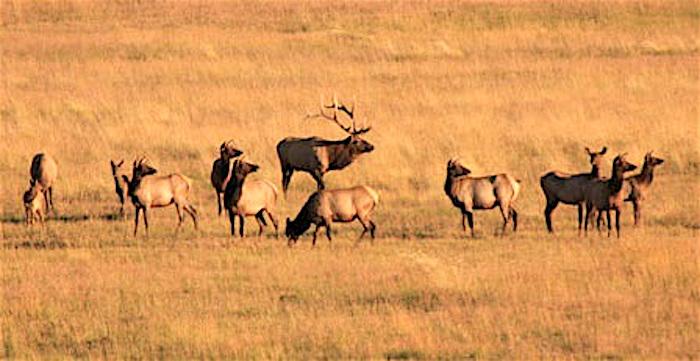
A road race is scheduled to go through a portion of Valles Caldera National Preserve at a time when elk are calving and black bears are with young/NPS
Less than a year after a runner in a road race was mauled by a black bear in Valles Caldera National Preserve, officials have approved another race through the park in northern New Mexico. And it is scheduled to be held when black bears are with new cubs and elk are calving, a time when both species are overly sensitive to human disturbances.
While backcountry travelers are told not to run from bears, as it could trigger the bruins to chase, the event scheduled for May 20 could bring upwards of 50 or so bear-bell-jangling runners jogging through the preserve. Cow elk also could be scared away from newborn calves at a time when the calves are trying to get as much nutrition as possible; if the cows flee, that could leave calves susceptible to predators, a park review of the road race said.
Despite those issues, Valles Caldera officials view the race as both a positive way to connect with a new demographic of outdoor users and to promote recreation, one of the tasks Congress gave Valles Caldera when it was added to the National Park System via the 2014 Defense Authorization Act.
“There is a long history of running events occurring within the Jemez Mountains and on the preserve for the last decade," said Kimberly DeVall, chief of interpretation and education for Valles Caldera. "Last year was the first year that we had an incident."
The Jemez Mountains that embrace the national preserve are a rugged, volcanically born range that climbs in places to more than 11,500 feet. According to the New Mexico Department of Game and Fish, the mountains probably hold 17 bears per 100 square kilometers, and elk habitat covers the range.
The National Park Service has been working with the High Altitude Athletics Club, which is sponsoring the run, to ensure the participants' safety, Ms. DeVall said Monday during a phone call. An emergency medical technician will have to be present at the preserve, and runners will have to wear or carry bear bells, she said.
“We are actually requiring more safety measures with this event that we require with the average park visitor," Ms. DeVall noted.
Park crews will not, however, travel the race course through the preserve ahead of the runners to check for black bears or elk with calves, she said.
At Public Employees for Environmental Responsibility in Washington, D.C., Executive Director Jeff Ruch highly criticized the decision to continue to allow the race in the preserve, saying it's inappropriate with the Park Service mission.
“How many more people need be mauled for these clueless officials to conclude this is a bad idea?” Mr. Ruch said Monday, citing the mauling last June of a woman who was attacked by a black bear after its cub was scared by runners and climbed into a tree. “Parks are supposed to protect their wildlife from harassment, not invite it.”
The run through Valles Caldera on May 20 is one leg of the Jemez Mountain Trail Run, an event staged by the High Altitude Athletics Club, which is based in Los Alamos, New Mexico. In addition to a 50-mile race, there will be 50-kilometer and 15-kilometer runs that day.
The club, in a runner's manual created for the three races, warned of possible bear encounters.
During a trail race in the Valles Caldera National Preserve a runner was attacked by a bear when the runner unexpectedly startled a mother bear with two cubs. The bear attached the runner to protect the cubs. As a result of this event, the Valles Caldera National Preserve is requiring the race to offer bear bells to all runners entering the Preserve, which applies to runners only in the 50 mile distance. Since bear activity was observed at many locations along the course, the race has decided to offer bear bells to any runner who would like to wear one regardless of the race distance.
The manual also includes information taken from the National Park Service on how to act if you spot a bear. Among the Park Service tips is a warning not to run.
Bears can run as fast as a racehorse both uphill and down. Like dogs, they will chase fleeing animals.
Valles Caldera officials, in deciding to approve the race, said it "could positively affect public perceptions of the accessibility and opportunities at [the park] and help meet some of the demand for recreational activities."
At PEER, Mr. Ruch said parks "are not supposed to sacrifice their assets or endanger visitors to curry popularity."
“As one of the newest national park units, Valles Caldera looks as if it sorely needs some professional guidance on basic resource management," he added.



Add comment